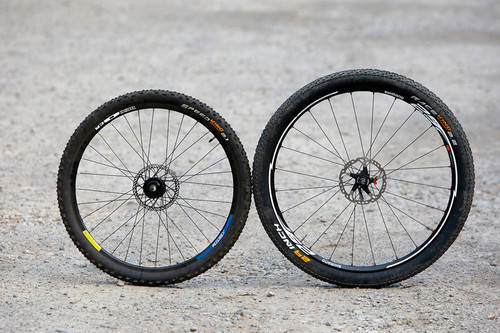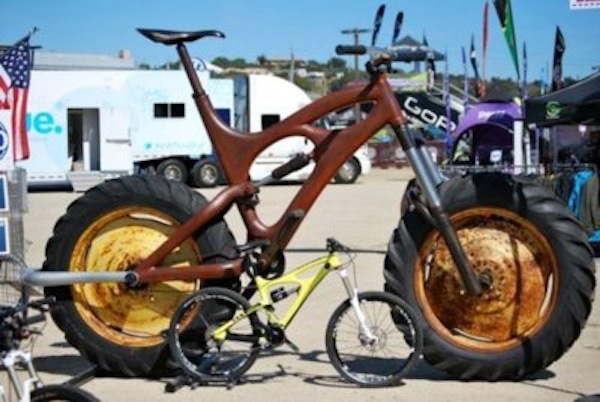Have you noticed the 29er rider who is adamant that this is the new mountain bike that will replace all others, and it is proclaimed with an almost religious fervour, and anyone who argues the point is disregarded as a poor ignorant disbeliever? Or the old stubborn 26er that is happy with the current world order and doesn't want to hear about the latest invention, even when the angels sing to follow the star to 29er land; "No! If it ain't broke, it don't need fixing!"

Well, we've all seen it, and perhaps lived it as well, but the question remains: "Which is best for me?" And that is the appropriate question, because neither bike is "the right bike" for everyone. So let us dispense with the emotions and opinions and try to see this choice clearly.
The features and benefits of the 29er:
- Rolls through rough rocky terrain more easily due to the larger diameter wheels. The increased wheel diameter results in a decreased 'angle of attack', meaning that obstacles strike the tyre at a comparatively low point in relation to the wheel axle.
- Increased grip. The tire contact patch is increased (by approximately 5%) which may lead to more grip when cornering.
- Momentum. Once moving, the greater angular momentum makes it easier to maintain high trail speed.
- Perceived stability. The longer wheelbase and heavier wheels may result in a more stable bike. The greater wheel weight increases "steer torque" which results in the sensation of feeling more stable when manoeuvring.
- Rolling resistance. This is related to 'angle of attack' but the larger tyres also experience less deformation, perhaps resulting in less rolling resistance.
- The larger wheel gives the sensation of riding more travel than you actually have! If you're looking at a 140mm 26" bike, also check out a 120mm 29er.
- Larger riders. The equation of wheel size to frame size definitely falls in favour of taller riders. 29er geometry is a good fit for a 6' (182cm) plus rider.
And the drawbacks:
- The larger wheels take more to get moving so acceleration is slower than a 26".
- Manoeuvrability may be an issue when riding tight, twisty single-track as steering response time is decreased.
- The larger size means greater weight, and probably where you don't want it (rotational mass).
- There have been reported issues with wheel deflection, probably a result of longer spoke lengths and some forks not stiff enough to cope with lateral forces from the larger diameter wheels.
- There are frame geometry issues with smaller riders.
- Availability and choice of components is limited at the moment, although this will rapidly change and soon could hardly be described as a drawback.
So what does all that mean? The questions to answer really are:
- Where do you ride?
- What style of riding are you into?
- How tall are you?
 The benefits of a 29er come into their own when ridden as a fast hardtail or shorter travel dual-suspension bike. For example: Cross country racing, trail riding, open rocky or rough trails are the perfect territory for 29er wheels and their growing domination of the market reflects this. Also note: For those who race, ride a 29er.
The benefits of a 29er come into their own when ridden as a fast hardtail or shorter travel dual-suspension bike. For example: Cross country racing, trail riding, open rocky or rough trails are the perfect territory for 29er wheels and their growing domination of the market reflects this. Also note: For those who race, ride a 29er.
For up to 120mm travel I would recommend a 29er hands down, unless your usual trails are full of very technical, tight single-track where the speed and momentum of the 29er platform may not be a realised advantage. In this situation try one first if possible before making your mind up. Even up to 140mm, you would be foolish to ignore a 29er as a potential option. Keep in mind also that a 120mm 29er may ride similarly to a 130-140mm 26" bike.
As travel increases some issues may arise with the 29" wheel size. In free ride and downhill applications, say 160mm and beyond, already big bikes become HUGE with 29" wheels! This may become a real issue when riding a technical downhill track. At the moment I would also question the capability of current components, (wheels, forks etc.) to stand up to the abuse of extreme riding practices when mated to a 29er. This will certainly change in the future as I can't see the market ignoring what I perceive to be a limitation currently.
And lastly, how tall are you? If the answer is 5 feet and a bit, definitely try before you buy. The much larger diameter wheels can create issues with smaller frame size geometry, and smaller riders may feel "swallowed up" by the frame, and have difficulty manoeuvring and generally being mobile on the bike. Conversely, the 6' plus crowd may have finally found a bike that fits them!

The best practise is to test ride both types with an open mind and attempt to come to your own conclusions. Both platforms have their advantages and I do not see one completely replacing the other (Not in the near future anyway). The proof is in the riding...always.


